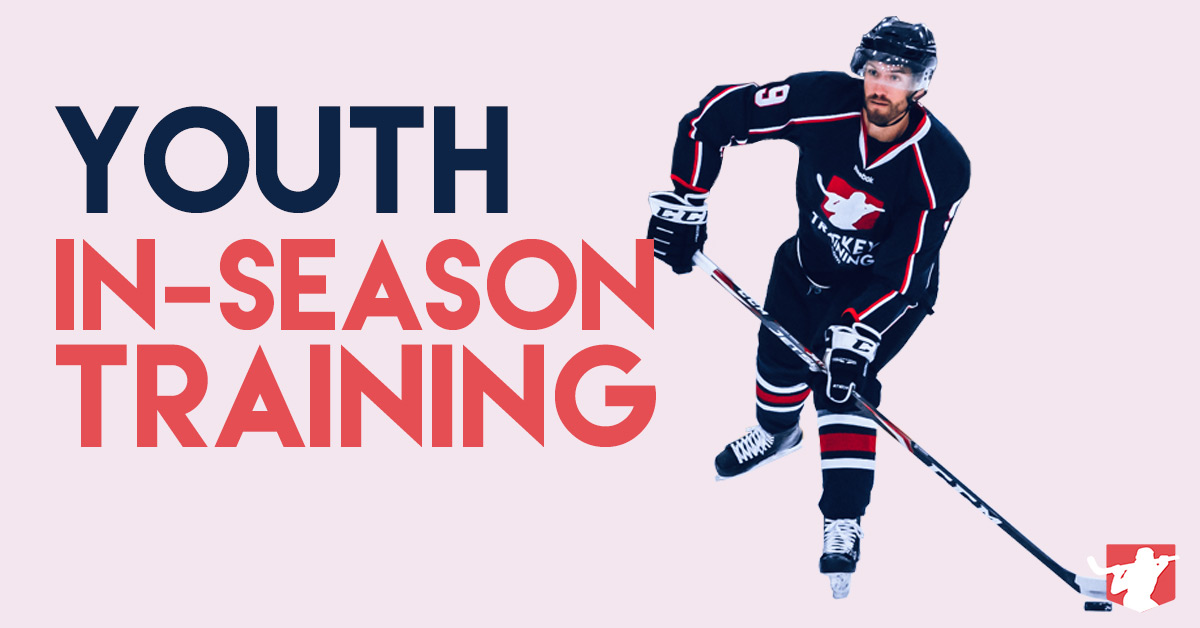In-season strength and conditioning is important at all levels of hockey, this includes youth hockey athletes.
A typical hockey season will last roughly six months, if you take this time off from your dryland work, this means your opponents are getting twice as much training as you are every year.
Hopefully, hockey players have a structured off-season program in place to improve their speed, agility, conditioning, and strength. However, a plan still needs to be in place to improve or at the very least maintain all of these athletic qualities throughout the season.
Think about it like this…
At the end of the year, if you skip your in-season training you’re going to be way behind everyone else who didn’t — and you will be at your absolute lowest level of detraining (and therefore, your absolute slowest and least conditioned) come time for playoffs which is supposed to be your highest priority for the entire year.
Not to mention, detraining is your highest risk factor for developing an injury throughout the season as well, so you have to consider the importance that carries as well.
In-season Hockey Training Program Design
In-season training program design is certainly a challenge given the already existing physical demands from the on-ice work in combination with how crazy a youth athlete’s schedule can get during the season.
But, it definitely is possible to work around all of these things — and if you do it correctly, you can expect your youth hockey players to have the best season of their life.
As far as the overall application of training strategy goes, you have to consider the on-ice training volume that they are already doing.
This on-ice training volume is more important than the off-ice training, there’s no getting around that. The work in your dryland work is in place to support and complement the hockey specific demands that occur during games.
For this reason, the training volume must be scaled back considerably so in comparison to the off-season.
In the off-season we don’t have your on-ice performance to worry about, so we can train very hard with high overall volume prescriptions.
In the in-season we don’t have that luxury, so we need to find a way to train that still allows the maintenance/progression of all the physical qualities responsible for hockey performance, but it needs to be done in a way that prioritizes recovery before games so that you are never taking any fatigue with you from your training out to the ice.
Always remember, we are doing dryland work for the purpose of becoming better hockey players and NOT for the purpose of just getting better at our dryland work.
Youth Hockey Training Schedule
In youth hockey, for the most part, the games are played on Friday and on weekends.
There will always be the occasional mid-week game, but they aren’t too frequent. This allows parents and coaches to safely and effectively train their youth athletes through their dryland work during the week and then leave enough time after the last workout and the first game so that the athlete is optimally recovered.
I like to recommend a two-day clearance here.
For example, if you play a game on Friday then your last hard training session should have been on Wednesday (and not Thursday or on game day!).
I want to emphasize that “hard training session” represents resistance training and/or hard conditioning work.
Things like mobility circuits, yoga, or low-intensity hockey specific drills can absolutely be done on game days or the days before a game — these things are always permitted because they won’t tax your recovery reserves in the same way that hard training does.
For example, this is the exact schedule of the brand new Youth In-season training program that I created this year:
DAY 1: Bodyweight resistance-based conditioning
DAY 2: Mobility and balance
DAY 3: Bodyweight resistance-based conditioning
DAY 4: Mobility, coordination, and reaction time
DAY 5: Off
DAY 6: Off
DAY 7: Off
Beyond this, I include exact instructions on how to optimally set up your plan based on when your team has games.
It’s kept really simple, the way in which the program is designed doesn’t necessitate a “set in stone” schedule. Frankly, I don’t think any in-season program should since people with real lives have hectic schedules around this time — not to mention things like school, work, tournaments, etc
I personally like to create youth in-season hockey training programs where you can move the days around each week over a 7-Day period to meet your exact schedule and still get your strength, speed, mobility, balance, coordination, and reaction time training in.
This is the primary reason my schedule is listed as “Day 1” to “Day 7” as opposed to instructing them that is must be on a Monday or Tuesday or whenever. It’s unnecessary and doesn’t make sense for almost all hockey athletes, coaches, and parents.
If you’re optimizing recovery methods and utilizing the golden rule of never training hard within two days of a game — you’ll be doing yourself a lot of good.
Resistance Training
At the youth level, one of the most difficult things to get through to parents is how resistance training is both safe and effective for young hockey players.
If you haven’t already, I would strongly suggest you read my previous work surrounding the research in this area so that you too can see that it’s not only safe, but, will also improve your kids speed, agility, conditioning, and resistance to injury out on the ice.
Here is a compilation of my work in this field:
Is Hockey Training Safe For Youth Hockey Players?
How Young Should Hockey Players Start Weight Training?
Now that that’s out of the way and you know that this is both safe and effective for youth athletes, the questions are:
Why should we strength train?
How should we implement it?
The Why
First of all, when I say “resistance train” it simply means performing exercises with any form of resistance.
It can be bands, dumbbells, barbells, medicine balls, cables, or your own bodyweight. If it provides resistance than you are resistance training.
For youth athletes, I prefer utilizing bodyweight-only training methods until they are 14-15 years old and already have plenty of bodyweight-only training experience under their belt.
The reason being is that just because training with weights is safe for kids, it doesn’t mean that it’s optimal for them to train this way.
I prefer bodyweight-only methods as there is a TON of progress youth athletes can make in the bodyweight-only world in all levels of hockey performance.
I also find that because they are forced to use their own bodyweight in creative ways to create more resistance (for example, moving from doing a push up on your knees, to a regular push, then to a feet elevated push up) it also forces them to dramatically improve their coordination, balance, and overall movement quality.
For athletic development, a well-designed bodyweight-only circuit crushes a machine-based circuit ten times out of ten for developing better hockey athletes.
The circuit method is a good route to go because you can check so many boxes in one shot. The way I set up the youth in-season hockey training programs and progression throughout the season ensures they:
- Maintain/build strength
- Maintain/improve speed
- Maintain/improve conditioning
- Maintain/improve explosive power
All in one shot, and then the mobility, coordination, balance, and reaction time drills are all placed on separate days to bridge the gap between both mental and physical performance.
Here’s what the typical youth in-season hockey workout should look like.
Example Youth In-season Hockey Workout
A1: Skater bounds – 3 x 3/side with 0 secs rest
A2: Alternating anterior reaches – 3 x 5/side with 0-30 secs rest
B1: Close grip push ups – 3 x 10 with 0 secs rest
B2: Alternating forward reaching lunges – 3 x 10/side with 0-30 secs rest
C1: Superman reps – 3 x 10 with 0 secs rest
C2: Bicycle abs – 3 x 10/side with 0-30 secs rest
D: Crossover step ups – 3 x 5/side with 30-60 secs rest
*To perform the above supersets (except for “D” as it is a standalone exercise), you are to perform all of the reps for the first exercise, then take no rest before going to the second exercise and completing all of the reps there, then rest 0-30secs before repeating the superset for 3 total rounds. Complete all three rounds of a superset before moving on to the next one.
Video Demonstration Of The Example Youth Workout
Final Thoughts
Although there was a lot of information in this article, trust me, there is so much more out there that I could discuss that just further supports the argument that in-season youth hockey training should be mandatory for any kid out there who is truly looking to become the best version of themselves out on the ice.
If you would like a completely “done for you” youth hockey training program designed to meet the needs of the in-season schedule in a hockey-specific way then you need to check out the brand new Youth In-Season Training Program.
This program, ESPECIALLY if the youth athlete hasn’t done proper in-season training periodization before, will be your “secret weapon” this year.


Thanks Coach–excellent stuff, per usual. If you couldn’t do sprints and certain jump/plyo-based exercises such as box and broad jumps for several weeks–thus putting power-and-speed in real “decay,” as you’ve just discussed–what could you recommend be done in the gym in order to retain or even build on in-season power/speed? (I’m still healing up from a lower-back sprain, and can plainly do some relevant training, while surely being wise to avoid others for a time. (I haven’t sprinted or done usual plyos for close to three weeks.) Based on your prior instructionals, I would think the following would help maintain speed-and-power, but welcome any-and-all of your guidance: (1) reverse-lunges with DBs; (2) split-squat jumps and hold; (3) sprinter-stepup jumps; (4) vertical jumps; (5) ab crunches (of the safe variety that you’ve described); and (7) plank variations. In a modest way, I’ve also done power-lifting on certain training exercises that wouldn’t hurt or impede recovery for the earlier-mentioned back sprain. Also, I know they get heavily criticized, but doing the hill intervals at the highest levels for the gym-exercise bike generates a real pump and burn (at least as to the VMO/quad), as do heavy, but explosive reps on the leg-press (or, “heavy” for me anyway–about 630 lbs on the last set of 4-6 reps. I know there are some monsters out there who’d use this weight, if at all, as a warmup). The question for the expert (you) is whether the exercises that I just listed above truly help with hockey speed-and/or power, or are they just exercises that aren’t going to really stop the “decay” on speed or power? Many thanks again.
Thanks for the kind words!
Depending on your level of development (advanced trainee vs. intermediate vs. beginner) the above can either improve or maintain your current status. So, it’s tough to say.
But, what I CAN say is that it will definitely help prevent decay — that much is true for sure.
Here’s a protocol I like my hockey athletes doing when they are injured so they have improvements in speed but aren’t subjected to the typical high-impact forces of some plyometric exercises:
A1: 45-Degree wall march x 45-60secs alternating
A2: Single leg contralateral reach x 15/leg
A3: Single leg hip thrust x 15/leg
A4: BW split squat x 15/leg
Repeat this protocol for three rounds, rest minimally in between exercises, and for 2-4 minutes between rounds.
Perform this during the times you can’t do high-impact stuff as it acts as a great “replacer” for those intense working sets. Then, when you’re all healed up, hit the big stuff again.